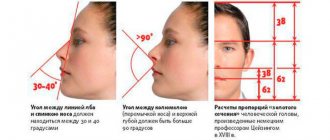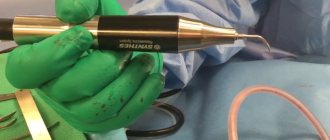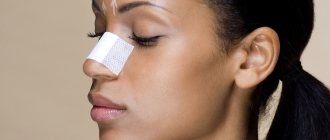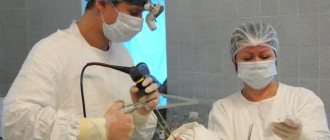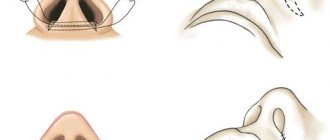The nose is not only a respiratory organ, but also an important detail of our appearance, which, unfortunately, is often far from the aesthetic ideal. A crooked nose or a nose with a hump, a nose that is too large or too small - this is what our patients very often complain about, because any, even the most insignificant, flaw in appearance can lead to the development of complexes, and in general, significantly spoil life. And this is not to mention that a deformed nose can make breathing difficult or cause snoring. Agree, these are not the most pleasant things either. Rhinoplasty, or, more simply, nose surgery, is designed to solve all these problems.
How is rhinoplasty performed?
There are two ways to perform rhinoplasty: open and closed. The second option is considered more preferable, since all cuts during the operation are made from the inside of the nose and after rhinoplasty there are no visible marks left on your nose - they are all inside. The open method (that is, dissection on the outside) is rarely used - with very complex plastic surgery options.
The operation in most cases is performed under general anesthesia and lasts from half an hour to two and a half hours. It all depends on the specific case. At the end of the operation, you will have self-dissolving sutures, which will disappear within a week, and cotton swabs will be inserted into your nostrils (these will be removed after 24 hours). In difficult cases, a plaster cast is also applied.
Complications
In order for the surgical intervention to be successful and to avoid any complications, a preliminary study of organic tissues and modeling of the future shape of the nose using a computer program are performed. Various gentle methods provide plastic surgery without complications. However, no patient is immune from their occurrence.
The development of complications is especially often observed in the first days of the postoperative period. Possible:
- bleeding from the nasal cavity;
- thinning of the epithelium;
- inflammatory focus;
- suppuration;
- bruises;
- adhesions in the sinuses;
- the appearance of dry crusts in the nasal cavity;
- deterioration of sense of smell;
- difficulty in nasal breathing.
The quality of rhinoplasty can only be judged after a year. During the entire 12 months after surgery, various complications may occur, some of them are considered completely normal and go away without medical intervention. The appearance of an inflammatory process in the nasal cavity is often accompanied by suppuration. In such a situation, antiseptics and, in rare cases, antibiotics are used.
What can rhinoplasty do?
Correction of the tip of the nose
This surgical option allows you to make the tip of your nose thinner or thicker, or correct the angle or projection. It is carried out internally. The surgeon adjusts the soft tissue and cartilage.
Correction of the nasal septum
This correction is also called septoplasty. It is carried out using an endoscope, which is essentially a micro-camera that allows you to “look” inside the nose and makes it possible to use the internal version of plastic surgery even when it comes to the nasal septum.
Nose wing correction
There are two options here: decreasing and increasing. In the first case, part of the wings on the outside is removed (as shown in the figure). In the opposite situation, the surgeon’s main task is to restore the support of the wings of your nose. For these purposes, a small fragment of cartilage tissue is taken either from the auricle or from the nasal septum.
Nose reduction
In this case, the part of the nasal bone that “spoils” your nose is removed. Thus, the operation allows not only to reduce the size of the nose, but also to correct its shape.
Indications
Rhinoplasty is almost always recommended by surgeons to restore nasal breathing or correct an external defect. The operation is prescribed:
- to eliminate a hump on the bridge of the nose;
- for correction of the tip of the nose;
- to correct the saddle shape of the organ.
It will help correct the asymmetry of the sides of the nose, shorten or enlarge it and model a beautiful shape.
The presence of a defect will only be determined by a practicing surgeon who will examine the organ with the necessary measurements. If the patient is overly concerned about the aesthetic defect of the nose, the doctor recommends rhinoplasty. The operation is contraindicated after 45 years of age - as the body ages, tissues are less susceptible to restoration. At the time of surgery, the nasal bones must be fully formed, so the operation is performed on people who have reached the age of majority. It is optimal if the operation is performed before 35 years of age.
Each plastic surgery is a complex surgical process. The doctor must completely solve the patient’s aesthetic problem, restore nasal breathing functions, and preserve important organ tissues.
Main medical indications for surgery:
- polyp;
- changes in tissue structure;
- congenital nasal deformity;
- nasal injury;
- cartilage damage;
- deviated septum;
- breathing problems;
- uneven development of organic tissues of the nose.
The causes of tissue deformation are often dysfunction and changes in the anatomy of the nose. Difficulty breathing can occur due to otitis media, bronchial diseases, atrophy of mucous tissue, rhinosinusitis, and asthma. Rhinoplasty helps prevent the development of oxygen starvation in the above pathologies.
In some situations, the patient desires surgical correction of the shape of the nose for aesthetic reasons. There is a desire to change the shape, shorten the nose, correct visible ugly defects.
Aesthetic indications for plastic correction are:
- disproportionality;
- ugly shape;
- large length and width;
- excessively short length;
- congenital deformity;
- hump;
- asymmetrical tip;
- wide nostrils.
With rhinoplasty, you can correct visible defects that disfigure your appearance or cause snoring. The operation will radically change the shape of the nose or its individual parts, allowing you to become an attractive person and change your life for the better - get a job, get married.
What to do before rhinoplasty?
If you decide to have rhinoplasty, then you will have to follow some simple rules:
- during the week before surgery, do not drink alcohol or drugs that thin the blood;
- if you are taking any medicine as prescribed by your doctor, you will need to inform our specialist about this during the preliminary consultation;
- at the time of the operation, your nose must be completely healthy (no ARVI or acute respiratory infections - this will also need to be taken care of).
Repeated plastic surgery
A significant proportion of patients require reoperation after primary plastic surgery. Nose correction can be divided into two stages or the result is unsatisfactory. Additional surgical intervention includes:
- elimination of scars;
- improved aesthetic result;
- modeling the ideal nose shape.
Typically, additional surgery does not take much time and is performed using local anesthetics. In medical practice, revision rhinoplasty is considered absolutely normal and occurs in 30% of cases. During repeated surgery, the nose is sculpted to an ideal state according to the patient’s wishes.
Additional surgery may be necessary if complications develop during the recovery period. The doctor prescribes a thorough examination and eliminates the problems that have arisen. When performing correction, the surgeon should not make any mistakes so that significant deformities do not occur.
What to do after?
Just a day after rhinoplasty, you can go home. The stitches, as we have already said, will dissolve on their own, and the splint can be removed after ten days.
You will be able to return to your normal rhythm of life within a week at the latest, but for several months after this you will need to observe some restrictions:
- do not sunbathe in the sun or in a solarium;
- exclude thermal procedures, especially saunas and steam baths;
- limit physical activity;
- In addition, it is not recommended to wear glasses at first, as they will put pressure on the bridge of your nose, so if you need permanent vision correction, get contact lenses during this time.
As you can see, nothing complicated. Moreover, the reward for following these rules is a perfectly shaped nose.
Rehabilitation
When planning an operation, you need to take time off from work in advance so that the recovery process after surgery goes smoothly. After surgery, silicone inserts are fixed in the nasal sinuses, which provide the patient with normal nasal breathing. In some cases, a suture is required.
Immediately after surgery, the tissues are swollen and painful. The areas around the eyes are also swollen. The swelling subsides within a week. After some time, the splints are removed from the sinuses, and the plaster is removed. Doctors recommend not to overwork yourself with physical activity after plastic surgery. During the rehabilitation period, you should not visit the pool or play sports. Wearing glasses is also recommended three weeks after plastic surgery.
To avoid causing nosebleeds, avoid eating too hot or cold foods. Daily walks in the fresh air and taking vitamin and mineral complexes are recommended.
Questions and myths
Rhinoplasty, like any other operation related to appearance, raises questions among patients, the answers to which many for some reason prefer to receive answers not from specialists, but on the Internet. Hence the many myths that accompany rhinoplasty. Let's try to figure it out.
Myth #1 – Rhinoplasty is painful.
As we have already said, the operation is performed under anesthesia, so there is no pain. Moreover, in comparison, for example, with breast surgery, rhinoplasty is considered a fairly simple and non-traumatic procedure.
Myth No. 2 – The effectiveness of rhinoplasty depends on the season
Some people believe that it is better to perform rhinoplasty in the summer so that the nose is not exposed to the cold, while others consider rhinoplasty to be an exclusively winter operation, because in winter it is easier to protect yourself from the sun’s rays. This is wrong. Rhinoplasty is equally effective at any time of the year. When exactly to carry it out is up to you to decide.
Myth No. 3 – It is very easy to identify a person who has had rhinoplasty.
Of course it’s easy, because his nose will become more beautiful and better. But seriously, rhinoplasty, as already noted, does not leave behind visible traces, so the likelihood that someone will find out about the operation is practically absent.
Finally
It should be understood that rhinoplasty requires from a plastic surgeon not only professionalism, but also the talent of a sculptor, because the doctor, in essence, creates a new shape of the nose. In this case, we are talking not only about the proper functioning of the respiratory organ, but also about its beauty. This is why it is very important to choose the right clinic.
The GENESIS Clinic is a staff of qualified specialists with a worldwide reputation. For more than ten years, plastic surgeries of any level of complexity have been performed within the walls of our clinic. Our clinic has hundreds of patients who, with our help, have already solved their appearance problems.
The GENESIS clinic always offers a comfortable visiting schedule. Your visit will be scheduled at the most convenient time for you. Modern gentle techniques allow us to shorten the length of your hospital stay as much as possible - we will let you go home a day after the operation.
Clinic "GENESIS" is a maximum of attention. Our specialists will take into account all your wishes regarding the upcoming rhinoplasty and answer any questions you may have.
Are you unhappy with the size or shape of your nose? Call the GENESIS Clinic and we will help you solve this problem!
Kinds
Correction of nasal cavity defects is divided into different categories:
- Changing the tip is a labor-intensive type of plastic surgery that requires extensive surgeon experience. It is used to eliminate hookedness of the organ, correct the axis, upturnedness and other defects.
- Correction of the main part – models the width of the nose, allows you to correct the shape and remove swelling of the nasal septum. The method is aimed at reducing the size of the nostrils.
- Correction of the columella – eliminates defects in the septum between the nostrils, eliminates excessively wide width or, conversely, its narrowness.
- Shape correction – corrects defects in the bridge of the nose, giving it correctness and aesthetic appeal. Surgery affects the cartilage and bones of the nose.
- The contour non-surgical method is based on acid injections that correct small external defects.
- Laser conchotomy – removal of hypertrophied mucous tissue. Used for nasal breathing problems.
- Septorhinoplasty – correction of cavity defects due to snoring.
- Reconstructive plastic surgery – helps to correct defects from previous operations.
- Grafting is based on the transplantation of cartilage of the ear, rib, and nasal septum to model the desired shape of the nose.
- Augmentation rhinoplasty – expansion of the nasal bones and correction of defects of the nasal skeleton.
- Non-surgical methods using gels help to model the shape of an organ without surgery for small defects.
There are two methods of rhinoplasty used in medicine: closed and open. With the open method, incisions are made in the skin, which allows the surgeon to visualize the nasal bones. With the closed method, interventions are carried out through small incisions that are not visible after the operation.
